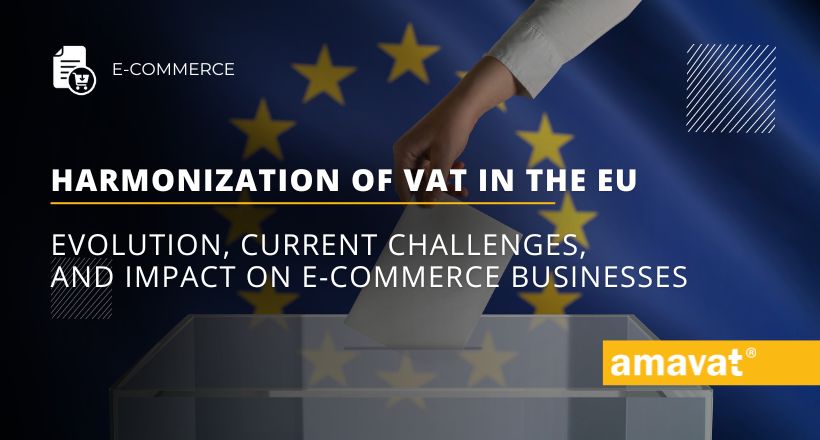Harmonization of VAT in the EU: Evolution, current challenges, and impact on e-commerce businesses
The harmonization of Value Added Tax (VAT) in the European Union (EU) is a key process for integrating the internal market, aimed at eliminating trade barriers between member states. This process, initiated several decades ago, has undergone many stages and forms the foundation of the single market. This article presents the evolution of VAT harmonization, current challenges, and its impact on the e-commerce sector.
Evolution of VAT harmonization in the EU
The harmonization of VAT in the EU began in the 1970s when member states decided to fund the budget of the European Economic Community from own resources, including VAT. A crucial step was the adoption of Directive 2006/112/EC, known as the Principal VAT Directive (PVD), which consolidated previous changes into one legal act.
In the 1980s, as part of implementing the white paper on the internal market, the European Commission identified the need to remove tax barriers. This led to the introduction of the principle of taxation at the place of destination for intra-EU transactions, meaning VAT is charged in the country of consumption.
The following years brought changes aimed at improving the existing system. Since 2000, the European Commission has taken steps towards a more consistent application of VAT regulations. In 2005, Implementing Regulation (EU) No 282/2011 was established, enabling member states to apply special rules to simplify VAT collection. Directives 2008/8/EC and 2008/9/EC introduced rules for collecting VAT on services provided between businesses in the country of service provision, further simplifying the system.
Current challenges in VAT harmonization
Despite years of efforts towards harmonization, the VAT system in the EU still faces numerous challenges. One of the main issues is the VAT gap, the difference between expected VAT revenues and actual collected funds. According to the Commission’s 2023 report, member states lost 61 billion euros in VAT revenues in 2021. This gap results from tax fraud and incomplete compliance with regulations.
To address these issues, the European Commission proposed the “VAT in the Digital Age” (ViDA) package in December 2022. The aim is to modernize the VAT system, increase its resilience to fraud, and improve business operations by simplifying VAT registration and introducing digitalization. The new regulations also consider the growth of the platform economy, which constitutes an increasing part of the e-commerce market.
Impact of VAT harmonization on e-commerce
For e-commerce sellers, VAT harmonization in the EU has both positive and negative effects. One of the main benefits is the simplification of administrative procedures, reducing the costs of conducting cross-border business. The introduction of the One-Stop Shop (OSS) allows businesses to register VAT in one member state and account for sales across the EU, which is a significant improvement over previous regulations.
However, new regulations also bring challenges. Mandatory digitalization and real-time reporting require businesses to adapt their IT systems and accounting processes. For many companies, this can be a significant financial and organizational burden. Additionally, differences in VAT rates between member states can affect the price competitiveness of products offered by e-sellers.
VAT harmonization and competitiveness of small and medium enterprises (SMEs)
Small and medium enterprises (SMEs) are the backbone of the EU economy, and VAT harmonization has a significant impact on them. On the one hand, administrative simplifications and the ability to use OSS significantly facilitate cross-border operations, reducing the costs associated with multiple VAT registrations in different member states. On the other hand, SMEs must face challenges related to adapting their accounting systems to new real-time reporting requirements.
One aspect affecting SMEs’ competitiveness is the diversity of VAT rates across EU countries. Although VAT harmonization reduces trade barriers, differences in rates can affect product attractiveness depending on the target market. Therefore, businesses must carefully plan their pricing strategies to remain competitive in different jurisdictions. Additionally, the availability of support tools, such as training or VAT compliance advisory, plays a key role in enabling SMEs to effectively benefit from harmonization.
It’s also worth noting the EU’s initiatives aimed at supporting SME digitalization, which is crucial in the context of new VAT regulations. Programs like “Digital Europe” and EU structural and investment funds offer financial and technical support for SMEs, helping them adapt to digital transformation. Through these initiatives, small and medium enterprises can not only better adjust to VAT harmonization requirements but also increase their overall competitiveness in the internal and global markets.
The future of VAT harmonization
VAT harmonization in the EU is an ongoing process that requires further actions and adjustments. The European Parliament and the EU Council continuously work on new regulations aimed at facilitating the internal market’s functioning and minimizing tax fraud. In the coming years, it will be crucial to further develop digital and technological tools that allow for more effective transaction monitoring and rapid response to irregularities.
Summary
VAT harmonization in the EU is essential for the effective functioning of the single market. Despite numerous achievements in this field, the VAT system still faces challenges related to tax fraud, differences in VAT rates, and the need for digitalization. For e-commerce sellers, VAT harmonization brings both benefits and challenges. It is crucial for entrepreneurs to stay updated with new regulations and adapt their processes to the dynamically changing rules. Only in this way can they effectively compete in the EU internal market and minimize the risks associated with non-compliance with VAT regulations.





